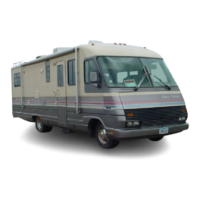44
Discovery, Discovery LXE, Pace Arrow, and Pace Arrow LXEt
Occupant and Cargo
Carrying Capacity
(OCCC):
Is the weight comprised of
occupants, cargo, full fresh
potable water weight including
water heater and tongue weight
of a towed load. Dealer installed
equipment and/or accessories
reduce OCCC.
LCCR (Load Carrying
Capacity Reduced) is
the amount the OCCC is
reduced due to vehicle
weight added by the dealer
between vehicle certication
and rst retail sale.
Gross Vehicle Weight
Rating (GVWR):
Maximum permissible
weight of this motorhome.
GVWR is equal to or greater
than the sum of UVW plus
OCCC.
Gross Combination Weight
Rating (GCWR): The sum
of the maximum allowable
loaded weight of this
motorhome and any towed
trailer or towed vehicle.
Gross Axle Weight Rating
(GAWR): Load-carrying
capacity specied by
manufacturer of a single axle
system, as measured at tire
ground interfaces.
Occupant and Cargo
Carrying Capacity
(OCCC):
Is the weight comprised of
occupants, cargo, full fresh
potable water weight including
water heater and tongue weight
of a towed load. Dealer installed
equipment and/or accessories
reduce OCCC.
LCCR (Load Carrying
Capacity Reduced) is
the amount the OCCC is
reduced due to vehicle
weight added by the dealer
between vehicle certication
and rst retail sale.
Gross Vehicle Weight
Unloaded Vehicle Weight
(UVW):
Is the weight of this vehicle
as built at the factory with
full fuel, engine oil, coolants,
propane. Factory UVW may
be increased by the addition of
dealer installed equipment and/
or accessories. UVW does not
include occupants, cargo, full
fresh potable water weight,
including water heater, and the
tongue weight of a towed load.
Weight Limits:
Numerous Federal, State and local
governments mandate weight limits.
Understanding the terminology
and performing proper weighing
procedures will help eliminate
confusion. It is important to weigh
the motorhome in a loaded, ready
to travel condition to ensure the
Occupant and Cargo Carrying
Capacity (OCCC), GVWR or
GAWR are not exceeded.
The total weight of the motorhome
in a loaded, ready to travel condition
must not exceed the Gross Vehicle
Weight Rating (GVWR) or the
GAWR for a single axle. The
GVWR is the maximum total
weight for which the motorhome
is rated including occupants, uids
and cargo and any dealer installed
equipment or accessories. The
GAWR is the maximum weight for
which a single axle is rated. The
GCWR is the combined total of the
GVWR and any towed load. The
tires, wheels, chassis frame and/or
drivetrain component(s) may limit
the GVWR, GAWR or GCWR or
any combination thereof.
Every recreational vehicle, even
of the same make and model, will
vary in actual loaded axle weight
due to different options, oor
plans, occupants and cargo. The
motorhome must be weighed in a
loaded, ready to travel condition to
determine actual weight carried by
each wheel position and axle.
Each wheel position must
be weighed to determine no
wheel position is overloaded
and to conrm no single axle is
overloaded. It is possible be within
the GVWR yet overloaded on one
wheel position or axle. For this
reason it is necessary to weigh
each wheel position to determine
the actual gross vehicle weight in a
loaded, ready to travel condition and
how that weight is distributed.
There are two important factors
to consider when loading the
motorhome: total weight and
balance. When loading for travel,
place heavy objects as low as
possible, preferably on the oor or
below in storage compartments.
Load weight must be distributed
as evenly as possible. Instructions
and diagrams to properly weigh the
motorhome are presented on the
following pages. The heaviest wheel
position on an axle will determine
the tire ination pressure for all
tires on that axle. Reference the tire
manufacturer load ination table to
determine the correct cold ination
pressure.
CAUTION:
State and Local authorities
may impose weight
restrictions to surface
streets, bridges and
parkways. These reductions
can include maximum single
axle weights or an overall
maximum weight limitation
based on the number of axles
per vehicle.

